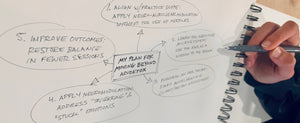Beyond NADA Protocol/AcuDetox
The challenge for nursing and mental health practitioners interested in the 5-point AcuDetox protocol often relates to the use of needles (which is regulated by many states and often limited to application by physicians or acupuncturists). Neuro-auricular modulation goes beyond acupuncture using tools within various scopes of practice. For example with a clinical-grade point-finder, a medical low-grade therapeutic laser, or through manual stimulation using ear seeds or an ear probe.
Since 2003, the internationally-endorsed continuing education program offered by the Canadian Institute of Auricular Medicine (CIAM), trains nurses and mental health professionals in neuro-auricular modulation — without the requirement for physician or acupuncturist supervision, or even the use of needles.
- Learn to address psychotherapy related challenges with trauma (i.e. defense mechanisms, resourcing, targeting, processing and more)
- Learn to address intervention challenges with addiction (i.e. coping mechanisms, trauma, disconnected neural pathways related to relapse, and more)
- Learn to reduce session time in preparation for EMDR (i.e. move beyond defense mechanisms, resolve dysregulation, improve targeting, facilitate processing, and more)
For healthcare professionals (mental health, nursing, physical therapy, etc.) who have wanted to use effective and efficient clinical auricular tools (Acudetox, ear acupuncture, transcutaneous auricular nerve stimulation, Auriculotherapy, and/or Auricular Medicine), CIAM offers this and more! The potential of neuro-auricular modulation methods goes far beyond the 5-point protocol. It offers skills for deep patient/client assessment and treatment insight — all without the use of needles (or the need for supervision by physicians or acupuncturists as otherwise limited by state laws[1]).
Watch the video, Beyond Protocols: Current and Dynamic Patient Insight.
Evidence-based Practice
Like the NADA protocol, neuro-auricular modulation and Auricular Medicine are evidence-based.[2-11] The fields of psychology and nursing have been especially interested in the NADA protocol because it is a nonverbal, nonthreatening intervention offering immediate calming effect on patients regardless of the specific substance used and regardless of whether a coexisting psychiatric disorder has been diagnosed.[1] Use of this transcutaneous auricular stimulation has gained increasing acceptance from agencies responsible for overseeing addiction treatment, and more than 500 state addictions programs in the United States use some form of acupuncture.[12] Over 1,500 addictions programs worldwide use some form of acupuncture.[13] NADA protocol acupuncture is increasingly integrated into dual diagnosis settings to help individuals with addiction and co-occurring disorders to better cope with a broad spec- trum of behavioral health issues. As a balancing treatment, it is of universal benefit, regardless of substance of abuse, in ameliorating dysphoric states such as depression, anxiety, anger, impaired concentration, decreased energy, and body aches/ headaches.[14] An original review article from the Journal of Addictions Nursing, offers more information and research references.
CE for Auricular Methods in Psychotherapy and Nursing
Future-proof your continuing education investment with Auricular Methods, go beyond what is possible with a 5-point protocol:
- Learn how read the microsystem of the ear as “a window to the brain”
- Access the limbic system (including amygdala, hippocampus, pain memory)
- Restore balance in the laterality between hemispheres
- Uncover “triggering” and “stuck” emotions
- And, much more
CIAM | Institute sign-in at www.IntegrateAuricular.ca







Comments